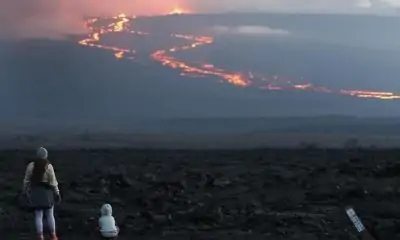(Bloomberg Opinion) — Nearly everyone we told about our cross-country trip on the Lincoln Highway asked: Are you going to Yellowstone? No, we would say, the Lincoln Highway doesn’t run through it, and we wanted to visit America’s forgotten towns, not its favorite parks. But as the question kept coming, my wife Laurel and I could sense people thinking: What’s wrong with you?
In looking for Lincoln’s spirit and what binds Americans together, we also knew that Lincoln laid the foundation for Yellowstone and the national park system that is beloved by liberals and conservatives alike. In 1864, he signed the first legislation setting aside land — in California’s Yosemite Valley — for “public use, resort, and recreation.” We had hoped to visit Yosemite after completing the Lincoln Highway in San Francisco, but the forecast called for snowstorms and temperatures in the teens, leaving me to fear every RVer’s worst nightmare: frozen water pipes.
Still, we resolved that on the return trip, we would follow a route that allowed us to experience a few national parks — bastions of egalitarianism that inspire a shared sense of national awe — by driving our Winnebago along portions of America’s oldest roads: Route 66, the Dixie Overland Highway, the Old Spanish Trail and Highway 61.
In early December, we spent three nights in Joshua Tree National Park, watching a full moon rise over the mountains and illuminate the desert floor. I took three hikes, getting lost on only one — the one on which I forgot to bring a water bottle. With the sun inching down in midafternoon, I ran into a hiker who steered me back to the correct trail. I debated whether to admit any of this to Laurel and decided I should. She cut me off: “Don’t tell me this!” I’m still new to marriage.
From Joshua Tree we take the road to Amboy, California, through miles of desert valley shrub brush flanked by jagged and barren mountains. At Amboy we pick up Route 66, whose fame has far eclipsed the Lincoln Highway and every other old national auto route, thanks largely to Hollywood and the traveling heroes whose epic adventures — in “The Blues Brothers,” “Easy Rider” and “The Grapes of Wrath” — helped capture the American imagination. About all the Lincoln Highway ever got were a couple of silent films and a line in the Woody Guthrie song “Hard Travelin’” — and even then, Route 66 overtakes it:
I’ve been walking that Lincoln Highway, I thought you knowedI’ve been hittin’ that 66, way down the road.
At Amboy, we pull it into Roy’s Motel and Café. It had been a thriving tourist stop until Interstate 40 opened in 1973. Then it closed down, along with the rest of the town, but never stopped appearing in movies — and, increasingly, Instagram feeds (including @looking4lincoln). The public will not let it go, and its owner sees a future in the past: The gas station has reopened, the neon lights are back on, and there’s hope the motel and café may yet be restored and reopened, too.
There is money to be made in nostalgia, and all across Route 66 from Amboy to Williams, Arizona, the story is same: Small towns are capitalizing on their links to the road and the travelers in search of a different time. In Oatman, Arizona, burros roam the street for tourists to feed when not browsing for Old West trinkets, or pausing to watch a high-noon shootout, or drinking at the Classy Ass Saloon. In Kingman, we have burgers and shakes at Mr. D’z — opened in 1992, but looking straight out of 1953. In Seligman, Old West camp and mid-century modernism sit side by side, the Road Kill Café competing with the Sno Cap Diner, which actually opened in 1953 and — based on the reviews, it’s now closed for the season — is more kitsch than kitchen.
Yet for every business trying to monetize the past, three or more stand vacant and boarded up. And as travelers soak in the cartoon version of the Old West, real-life cowboys and cowgirls are fighting government policies that they fear will destroy their way of life.
On a Saturday morning in Kingman, Arizona, Laurel and I drive out to the Rafter S Ranch to meet Emmett and Lori Sturgill. Emmett’s father was a cowboy who taught him the trade. “When I was growing up, the people that owned the ranches had a TV. I told my dad when I was 15 years old: I want to own a ranch. I don’t want to work on the ranch because I want to have a TV. We ain’t never had no TVs.”
Emmett had a 30-year career in law enforcement, working narcotics trafficking for the state and as a cowboy on the side, saving enough to become a part-owner of a ranch. After the police work finished for the day, the ranch work began.
“All my vacation and all my weekends and all my holidays, they were all spent at the ranch. There wasn’t any vacations. There wasn’t any holidays, but it was my passion.” He isn’t complaining. “The good Lord has just been just really good to me and allowed me to do that. So many people don’t get to realize their childhood dreams. I’ve been very lucky, and I’ve worked really hard to make that happen.”
He and Lori own a ranch at the base of the Grand Canyon that is 180,000 acres — 12 times the size of Manhattan. It’s hard for me to fathom how a single piece of property could be that big, and it’s not even the biggest ranch in the county. “Just to check our waters” — making sure the water feeders are full — “is about 100 miles,” says Lori. The ranch is 26 miles long and six miles wide. “Then, as soon as you get out there, invariably something’s broke.” The days are hard and long. They have just one employee, partly because workmen’s comp is so expensive — $2,100 a month, which is more than the salary they pay him.
Much of their ranch is federal land overseen by the Bureau of Land Management, which limits the size of their herd. They have a permit for 500 mother cows but because of the drought, and their desire to prevent overgrazing, they’ve kept the number below 400. Lori grew up on a farm and loves — and has a way with — animals. As we talk on their back porch, a half-dozen dogs join us, as does a 7-week old burro that they took in as a rescue and that Laurel falls in love with immediately. A pheasant sits atop a trailer, pigs explore the yard, and horses move in and out of the corral — they have an entire mountain to roam freely.
There are virtually no fences on the Rafter S ranch. It’s all open range, and the cows wander over the mountains and valley, eating as they go. Driving in, we had seen signs to watch for cattle on the road. “We put reflective ear tags in our cattle, and we still lose about eight or 10 a year,” says Emmett. The neighboring ranch, which has more exposure to the road and does not use reflectors, loses 30.
The road to the Grand Canyon Skywalk runs through their ranch. “We used to have a dirt road. No problem. Now, they come in and they paved the road. They built the Skywalk. They bring a million people here and they run over our cattle now and they want me to fence the road. Well, it’s about a million and a half dollars for me to fence that road. I can’t afford to fence that road. Arizona is an open range state. I was here before they were, but that doesn’t seem to matter.”
He says state legislators from Phoenix and Tucson are “trying to do away with the open range laws here, which will put all the ranchers out of business. I don’t have a million and a half dollars to fence it.”
A million and half dollars for six miles of fence?
“I could actually finish it for $70,000,” says Emmett. “The $1.6 million that I’m talking about is to comply with the county regulations. Because if I do that, everywhere there’s a turnout I have to put in a $70,000 cattle guard. They won’t let me put in a gate — and it has to be county approved, state approved — this, that and the other thing.”
It’s not just the fence. Lori wanted to put up shades on their water feeders, “so that the afternoon west sun is hitting the shade. And that way the water’s cool [which] helps prevents moss and algae from growing on it. But besides that, cattle can drink it better. They don’t want to sit and drink water that’s 130 degrees. When they don’t have proper water in their system, they’re not digesting correctly.” But the water feeders sit on BLM land, and the BLM won’t let her do it — or plant trees that would provide shade — without going through a National Environmental Policy Act process, which can take years and cost a lot of money. “So I went and bought 40 acres right next to that, so that I could put up my own shade on my own property.”
It’s not just the shades, either. Lori put up a note on Facebook offering an opportunity to a local butcher to start her or his own business: She’d build a butcher shop and buy all the equipment, and the butcher could use it free of charge, in exchange for butchering some of their cows.
Emmett explained what happened next. “It wasn’t 12 hours [before] the Department of Agriculture started inundating us with, ‘You can’t do that. And this is the regulation.’ Sent us five books full of regulations, hundreds of pages.”
Lori could not believe it: “I even have a relationship with the Department of Ag, but right away, that’s their first response. As opposed to what you can do, it’s all about what you can’t do. And I think: Why have we gotten to that point in our life?”
Time and again they return to examples of government bureaucracies being devoid of common sense, yet still always seeming to know best. Emmett: “They’ll bring people in here from Oregon. Well it rains every day in Oregon. It rains three times a year here. So don’t you bring me a guy from Oregon that thinks there should be green grass. And so he tells you you’re overgrazing your range when you’re not.”
They both see arrogance in the way the agencies prioritize college degrees over practical experience. “I don’t have a college education, she doesn’t have a college education,” Emmett says. “So we must be idiots because they went to college and they know better. They haven’t been out here on the land.”
In citing the government’s mistakes, Emmett says ranchers have learned to deal with the government’s biggest weapon — scientific studies — by embracing science. “Science has turned out to be the ranchers’ best friend, believe it or not.” He cites the government’s longstanding fire suppression practices, rather than controlled burns, which have played a large role in the Western wildfires. His father had taught him that Smokey the Bear was nothing but propaganda. “He said, ‘They’re trying to brainwash American people into saying that the fire is bad — and fire is good. You need fire to sustain.’”
The Endangered Species Act is another headache. In 1987, the federal government added the Mexican vole — a mouse — to the list of endangered species based on, Emmett says, a single study that lacked a proper taxonomy. Subsequent studies cast doubt on whether it was in fact a distinct subspecies in the mountains around Kingman, or merely the same type of mouse found in many regions. He says someone lost a ranch when the vole was found to be present on it — the government took it away — and it cost taxpayers millions of dollars in added expenses to design roads and other infrastructure to protect the vole.
“I’m all about protecting the panda bear and whatever else. But for God’s sakes, let’s be reasonable. And number one is: Let’s make sure that it is endangered.”
The U.S. Fish and Wildlife Service considered removing it during the Obama administration, as the state of Arizona had petitioned, but never acted. The Trump administration did, six months into its term.
I ask how the Trump years have been for them.
“Lifesaving,” says Emmett.
I ask him for an example besides the Mexican vole. He doesn’t hesitate.
“There’s a wash right here” — a creek bed that carries runoff during a monsoon. Most of the year it’s bone-dry. “Under Obama, that was a navigable waterway, and all of the regulations concerning navigable waterways applied to that — and on our private property. Now think about this for a minute. When Congress passed the navigable waterway act, navigable waterways meant a barge would move commerce. But for a rancher, if I wanted to put a road there, I’d have to go through the Army Corps of Engineers and get permits. And they would have to do NEPA studies, which take an average of four years.”
The Sturgills are not antigovernment. “I think there’s a place for them,” Emmett says. “I don’t think that we should eliminate them. I’m going to make a living off of public land — I’ve got a million dollars invested here, and they have a role to play. If there are guys who don’t manage the land — there are very, very few, but there are some. And so in that case, there should be someone to come in and stop them.”
Emmett takes us out to see some of the cattle, and they look as big and healthy as any cow grazing green grass back east. “If it doesn’t rain in the spring, we’ll probably sell almost all of our cattle.” Without enough to eat, a cow may not get pregnant — and “if she has a calf, the calf is puny. Then the calf doesn’t sell very good. It’s a whole system.”
Ranchers have been working that system for generations. But it’s not getting any easier. On the previous ranch Emmett owned, he had to hire a lawyer to fight an effort by wealthy Phoenix horse lovers who wanted to turn his ranch into a sanctuary for wild horses, even though — as it turned out, says Emmett — the horses belonged to a neighboring ranch.
Just off Route 66, there are still cowboys and cowgirls who are making their living selling beef, not Old West nostalgia. Maybe someday their fight for survival against government bureaucracy will be the stuff of legend that attracts tourists from all over. But I hope not. They have too much traffic as it is.
This column does not necessarily reflect the opinion of the editorial board or Bloomberg LP and its owners.
Frank Barry is a columnist for Bloomberg Opinion. This column is part of a series, “Looking for Lincoln: A Portrait of America at a Crossroads.” It features reports from Barry’s journey west along the Lincoln Highway, a zigzagging network of local roads running from Times Square to the Golden Gate Bridge, from Sept. 11 to Election Day.
©2020 Bloomberg L.P.
Let’s block ads! (Why?)

Source link
Related


































